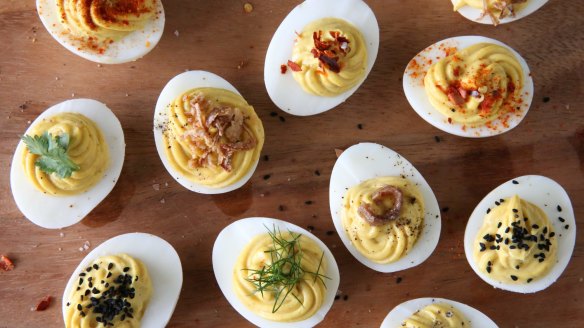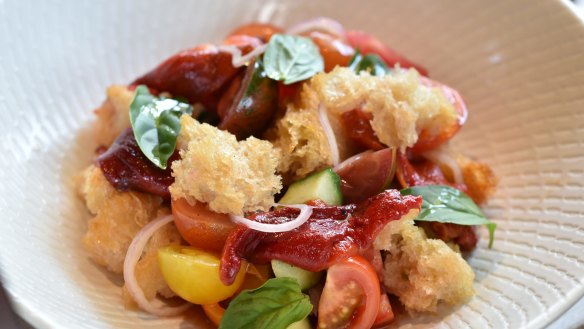Small plates aren't a trend - it's time for a supper resurgence

- Jill Dupleix's recipe for devilled eggs
- Tuscan bread salad - panzanella recipe
- What to cook with leftover rice
COMMENT
The American nutritionist Adelle Davis once said we should eat breakfast like a king, lunch like a prince and dinner like a pauper. Because of today's schedules, most people reverse that order, grabbing a quick bite before work, a sandwich on their lunch break and a full dinner at night, when everyone is home and can stuff themselves before bedtime.

No one will starve either way. But because we work at home, my husband and I have had the great pleasure of putting the Davis plan into practice, and we sleep better for it.
Long before small plates became the restaurant rage, they were the foundation of our evening suppers. With a few of them on the table, we nibble, graze or nosh until we're just full enough, along with drinking a glass of wine.
The ingredients for these light meals come mostly from our garden. Usually, they are very simple, with little or no cooking involved. Often there's one non-garden item, such as a wedge of cheese, devilled eggs, a bowl of nuts, a bit of cold sliced meat, a can of sardines or fresh oysters, for a splurge.
Long before small plates became the restaurant rage, they were the foundation of our evening suppers.
Because we can grow salad greens all year in our small home greenhouse, we'll often start with those, adding a few cooked vegetables on top. In early summer, those might be asparagus, spring onion, the first snap beans, little carrots or baby new potatoes, drizzled with vinaigrette. We might add toasted, buttered croutons, cubes of cheese, spring onion or fresh herbs.
The first asparagus is a main event, steamed and piled on the plate with just salt, pepper and butter. When the first garden peas come in, they are so sweet that we eat them raw from a big bowl in the middle of the table, popping them into our mouths and tossing the pods into a second bowl. If there are sugar snaps, we eat them pod and all.
Items such as asparagus, peas, spring onion and broccoli make great omelets, too - with or without cheese. Sometimes that's the entire meal. Didn't the English author Elizabeth David write a whole cookbook called An Omelette and a Glass of Wine?
In summer, great platters of vegetables make it onto the evening table, ready for appetites well fuelled by the long outdoor days.
There might be sliced tomatoes with basil eaten with a loaf of garlic bread, or the two chopped together in a big bowl to make that great Italian salad called panzanella. We'll set out sliced cucumbers with yoghurt and mint or with sour cream and dill.
We like potato salad with lots of herbs, and gazpacho made from tomatoes, capsicum, cucumbers, celery and garlic. Vichyssoise with herbs and lemon is great for hot weather. Squash blossoms, stuffed with cheese and batter-fried in olive oil, are filling and can be a meal in themselves.
The first corn on the cob is also a whole meal, especially with toast to mop up the butter. The first artichokes are gorged on, too. Both are best enjoyed outdoors if the mosquitoes aren't too bad. And the fruits! Bowls of strawberries, raspberries, blueberries, blackberries. Piles of peaches, melons sliced on a wooden board, oozing juice.
As the weather gets cooler, other vegetables call the shots. Supper might be a quick stir-fry of bok choy, tatsoi, shredded fennel and carrots. Steamed cauliflower goes well with pine nuts and brown butter; steamed cabbage with brown butter and caraway seeds. Thinly sliced kohlrabi can be topped with goat cheese. Salads can be strewn with sliced, raw baby Japanese turnips.
When seriously cold weather arrives, salads keep marching on. Cut-and-come-again lettuce and rocket need some protection against freezing temperatures; spinach and kale are hardier, and their leaves are salad-tender when it's cold.
Two of my favourite winter fortifiers are made with extras from the fridge. One is colcannon made with leftover mashed potatoes, warmed up with spinach or kale, along with bacon or butter. The other is leftover rice, fried in a little toasted sesame oil with carrots, onions and any other vegetable that's on hand.
A few nights ago, hungry from working in the cold, we put together four small plates from what we could find. One held stored apples, along with healthy, seed-filled crackers and a robust huntsman cheese. Another combined radishes and raw carrots just pulled from the soil in the greenhouse. We filled another with rounds of butternut squash cooked slowly in a buttered cast-iron pan. And the last was a salad of rocket and Belgian endive topped with slow-roasted beets and vinaigrette.
It was a feast, not quite for a pauper but fine for a couple of peasants, very well fed.
Barbara Damrosch is the author of The Four Season Farm Gardener's Cookbook.
The Washington Post
Restaurant reviews, news and the hottest openings served to your inbox.
Sign up- More:
- Restaurant news